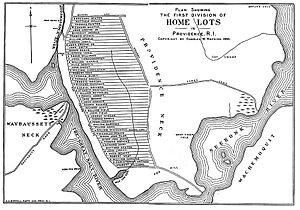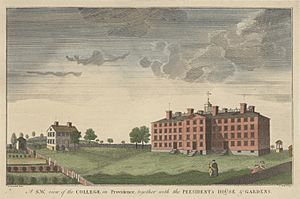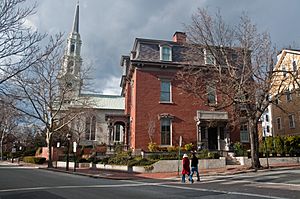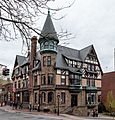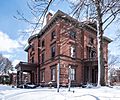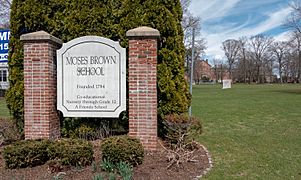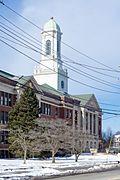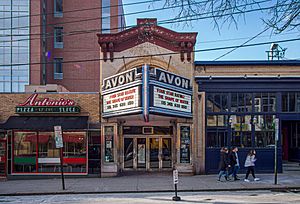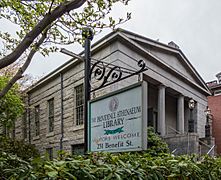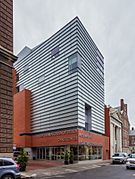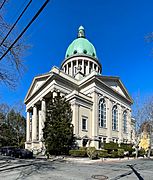College Hill, Providence, Rhode Island facts for kids
Quick facts for kids
College Hill
|
|
|---|---|
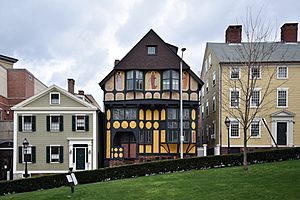
The Fleur-de-lys Studios (1885) and Deacon Taylor House (1785)
|
|
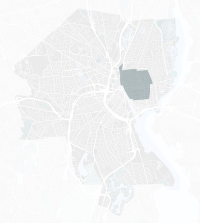
Location of College Hill within Providence
|
|
| Country | |
| State | |
| City | Providence |
| Area | |
| • Total | 1.99 km2 (0.770 sq mi) |
| Population | |
| • Total | 9,334 |
College Hill is a really old and important neighborhood in Providence, Rhode Island. It's one of six neighborhoods that make up the city's East Side. You can find it between South and North Main Street on the west, Power Street on the south, Governor Street and Arlington Avenue on the east, and Olney Street on the north. The main shopping area is along Thayer Street, which is a popular spot for students.
College Hill is known as the wealthiest neighborhood in Providence. Its average family income is almost three times higher than the rest of the city.
Parts of College Hill are protected as special historic areas. This is because of their amazing old houses. In 2011, the American Planning Association even called it one of the "Great Places in America."
Contents
What's in a Name?
The name "College Hill" has been used since at least 1788. It describes two things: the neighborhood's hilly shape and the many colleges located there. These include Brown University, Rhode Island School of Design, and Pembroke College. Bryant University used to be here too, but it moved.
Before Brown University moved to Providence in 1770, this area was known as Prospect Hill.
A Look Back: College Hill's History
Long before English settlers arrived, the Wampanoag and Narraganset Native American tribes lived in this region.
Early Settlement Days
In 1635, Roger Williams, who had different religious ideas, started a settlement called Providence Plantations. It was near where the Moshassuck and Woonasquatucket Rivers meet. By 1644, this settlement grew around a natural spring at the bottom of what is now College Hill. In 1638, settlers were given plots of land, about six acres each. These long, narrow plots stretched from Towne Street (now Main Street) to Hope Street, mostly within College Hill. Back Street, which was a series of paths, eventually became Benefit Street.
In 1770, the college that later became Brown University moved to College Hill. Its campus was built on land bought by Moses Brown and John Brown.
By the time of the American Revolution, the area at the bottom of the hill was busy. It had docks, warehouses, shops, public buildings, and homes. Benefit Street had several hotels, including the Golden Ball Inn. Famous guests like George Washington, Thomas Jefferson, and Marquis de Lafayette stayed there.
The 1800s
In the 1800s, businesses on North Main Street focused a lot on trading precious metals and jewelry.
In 1893, the Rhode Island School of Design (RISD) moved to College Hill. It had been in Downtown Providence before. Over 100 years later, RISD grew even more. It moved its main library, student dorms, and art studios into buildings downtown.
The 1900s
In 1935, Bryant College of Business Administration also moved to College Hill from Downtown Providence.
Starting in 1922, Brown University began buying more land. They wanted to build more housing for their growing number of students. This led to the building of Keeney and Wriston Quadrangles between 1949 and 1957. To make space, 59 historic homes were taken down.
In the middle of the 1900s, the area closer to the waterfront became a neighborhood for working-class families. Some older houses were considered for demolition as part of city plans to improve areas.
Because Brown University was expanding and there were plans to change the area, local groups formed to protect historic buildings. In the mid-1950s, the Providence Preservation Society (PPS) and the City of Providence worked together. They got money to study how to save and improve historic areas. This led to a plan in 1959 called College Hill: A Demonstration Study of Historic Area Renewal. The plan suggested using both public and private money to restore Benefit Street. The goal was to make the area more valuable. The PPS then led efforts to fix up old buildings, remove very run-down ones, and even move historic houses from other parts of Providence to College Hill.
These efforts were great for saving old buildings. However, they also changed the neighborhood. Many working-class families, including African-American and Cape Verdean communities, had to move out. The area around Benefit Street, which used to have different types of buildings, became mostly residential homes.
Amazing Architecture

College Hill has many different styles of buildings from the 1700s onwards. You can see both homes and larger institutional buildings.
As the oldest part of Providence, the neighborhood has some of the city's very first structures. These include the Governor Stephen Hopkins House (1707), the Benjamin Cushing Sr House (around 1737), the Jabez Bowen House (1739), and the John Corliss House (1746).
College Hill is especially famous for its large, grand homes from the 1700s and 1800s. Many of these are on or near Benefit Street. Some examples are the John Brown House (1786), Nightingale-Brown House (1792), Edward Dexter House (1795), and Thomas P. Ives House (1803). Others include the Corliss-Carrington House (1812), Thomas F. Hoppin House (1853), and Governor Henry Lippitt House (1865).
-
Corliss-Carrington House (1812)
-
John Brown House (1786)
-
The Thomas P. Ives House (1803)
-
Governor Henry Lippitt House (1862)
Other cool buildings to see are the Fleur-de-lys Studios, Providence Athenaeum, Old State House, and Brick Schoolhouse.
Almost all the buildings near historic Benefit Street have been restored. Special rules make sure that any new buildings fit in with the old styles. Because this area has one of the best collections of restored 18th and 19th-century buildings in the U.S., a lot of money is invested in keeping it nice.
Who Lives Here?
About 75.6% of College Hill residents are white, and 13.6% are Asian. These numbers are higher than the average for Providence. African-Americans and Hispanics each make up about 5% of the population. Many people living here are students who attend the local colleges and universities.
The average family income in College Hill is $121,521, which is much higher than the city's average. Only about 5% of households live below the poverty line.
Colleges and Schools
College Hill is home to the main campus of Brown University. Most of the Rhode Island School of Design (RISD) is also here, with its buildings right next to Brown on the western side of College Hill.
The Moses Brown School, on Lloyd Avenue, and the Wheeler School, on Hope Street, are well-known private schools in the neighborhood. Hope High School is a major public high school in Providence. It's located at the corner of Hope and Olney Streets.
-
University Hall (1770) at Brown University
Shopping and Fun
Thayer Street
You'll find many cafes, restaurants, and shops along Thayer Street, right next to Brown University. Both streets have lots of small, local shops, though Thayer Street also has a few chain stores. Brown University's bookstore is on Thayer Street.
The Avon Cinema on Thayer Street is a famous landmark in College Hill. It's an old movie theater that dates back to the early 1900s.
Parks to Explore
- Prospect Terrace Park is at the top of College Hill. From here, you get an amazing view of Downtown Providence and the city beyond.
- Riverwalk is along the Providence River. This is where part of the WaterFire festival, a cool art event with bonfires on the water, is held.
- Roger Williams National Memorial is on North Main Street. It honors the founder of Providence.
- Veterans' Memorial Park and Market Square are between South Main Street and Canal Street.
Cool Landmarks
The western edge of College Hill is the oldest part of the city. The College Hill Historic District covers much of this area. It's even recognized as a special National Historic Landmark District by the U.S. government. The Providence Preservation Society and the Rhode Island Historical Society have worked hard to save many historic buildings here.
Some important landmarks include:
- The Rhode Island School of Design Museum
- The Old State House
- The First Baptist Church in America
- The First Christian Science Church on Meeting Street – a church with a dome.
- The Central Congregational Church
- The Providence Athenaeum – one of the oldest libraries in America, located on Benefit Street.
- State Arsenal – an old building used for weapons during the American Civil War. It was also the first headquarters for the Rhode Island State Police.
- The Shunned House
- Dr. Willett house, 10 Barnes Street
- Ward house, 140 Prospect Street
- Birthplace of H.P. Lovecraft, 456 Angell Street, (formerly 194 Angell Street)
- Market House
-
The Old State House
Famous People From Here
- Ambrose Burnside (a military officer and politician)
- Stephen Hopkins (politician)
- Sarah Helen Whitman
See also
 In Spanish: College Hill (Providence) para niños
In Spanish: College Hill (Providence) para niños


